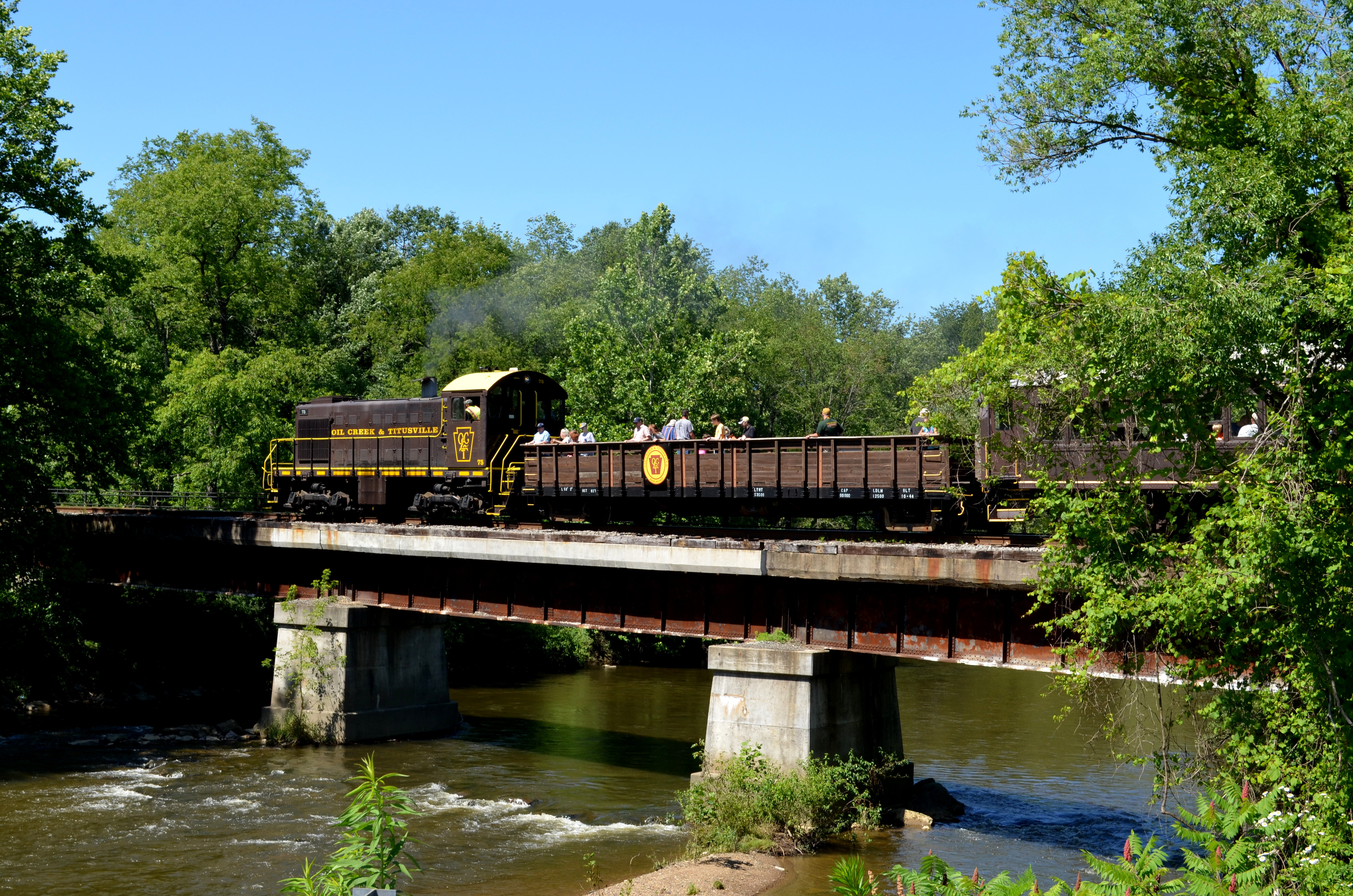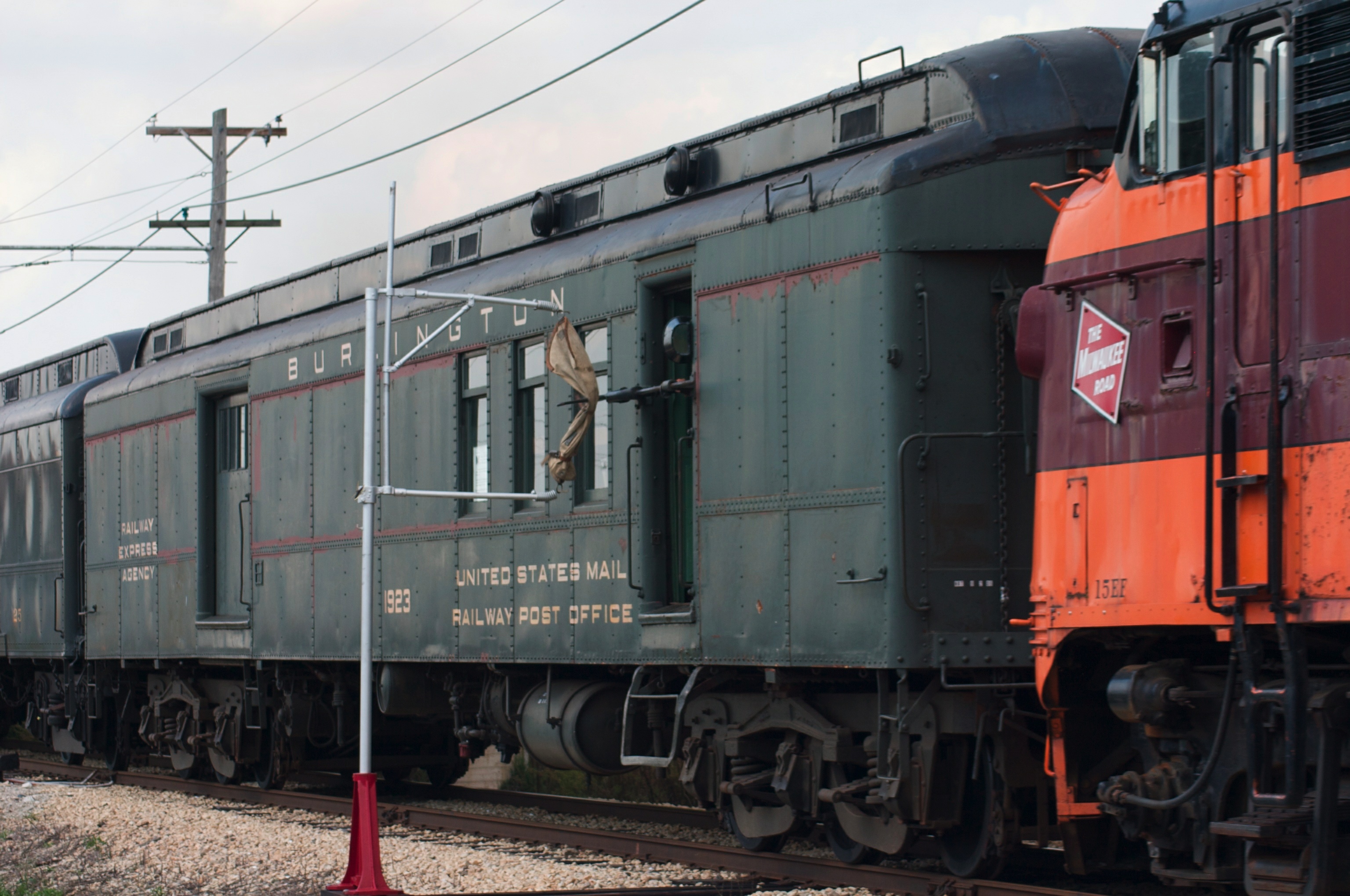|
Oil Creek And Titusville Railroad
The Oil Creek and Titusville Railroad is a tourist railroad that runs from Titusville to Rynd Farm north of Oil City in the U.S. state of Pennsylvania. The Oil Creek and Titusville Lines is the designated operator of the railroad, as well as the freight carrier on the line. History The Oil Creek and Titusville operates over tracks that were originally built as the main line of the Buffalo, New York and Philadelphia Railroad in the 1880s; trackage in Titusville was originally owned by the Dunkirk, Allegheny Valley and Pittsburgh Railroad. The Buffalo, New York and Philadelphia was reorganized in 1887 into the Western New York and Pennsylvania Railroad, which was eventually acquired by the Pennsylvania Railroad in 1900. The Pennsylvania was merged with the New York Central Railroad in 1968 and became Penn Central. In 1976, Penn Central went bankrupt, along with several other railroads, and was combined into Conrail. In 1986, the line was acquired from Conrail by the Oi ... [...More Info...] [...Related Items...] OR: [Wikipedia] [Google] [Baidu] |
Crawford County, Pennsylvania
Crawford County is a county in the Commonwealth of Pennsylvania. As of the 2020 census, the population was 83,938. Its county seat is Meadville. The county was created on March 12, 1800, from part of Allegheny County and named for Colonel William Crawford. Crawford County comprises the Meadville, PA Micropolitan Statistical Area, which is also included in the Erie-Meadville, PA Combined Statistical Area. Geography According to the U.S. Census Bureau, the county has a total area of , of which is land and (2.4%) is water. It has a warm-summer humid continental climate (''Dfb'') and average monthly temperatures in Meadville range from 24.9 °F in January to 69.5 °F in July, while in Titusville they range from 24.2 °F in January to 68.8 °F in July Adjacent counties * Erie County, Pennsylvania, Erie County (north) *Warren County (east) * Venango County (southeast) * Mercer County (south) *Trumbull County, Ohio (southwest) *Ashtabula County, Ohio (west) ... [...More Info...] [...Related Items...] OR: [Wikipedia] [Google] [Baidu] |
New York Central Railroad
The New York Central Railroad was a railroad primarily operating in the Great Lakes and Mid-Atlantic regions of the United States. The railroad primarily connected greater New York and Boston in the east with Chicago and St. Louis in the Midwest, along with the intermediate cities of Albany, Buffalo, Cleveland, Cincinnati, Detroit, Rochester and Syracuse. New York Central was headquartered in New York City's New York Central Building, adjacent to its largest station, Grand Central Terminal. The railroad was established in 1853, consolidating several existing railroad companies. In 1968, the NYC merged with its former rival, the Pennsylvania Railroad, to form Penn Central. Penn Central went bankrupt in 1970 and merged into Conrail in 1976. Conrail was broken-up in 1999, and portions of its system were transferred to CSX and Norfolk Southern Railway, with CSX acquiring most of the old New York Central trackage. Extensive trackage existed in the states of New York, Pennsyl ... [...More Info...] [...Related Items...] OR: [Wikipedia] [Google] [Baidu] |
Caboose
A caboose is a crewed North American railroad car coupled at the end of a freight train. Cabooses provide shelter for crew at the end of a train, who were formerly required in switching and shunting, keeping a lookout for load shifting, damage to equipment and cargo, and overheating axles. Originally flatcars fitted with cabins or modified box cars, they later became purpose-built with projections above or to the sides of the car to allow crew to observe the train from shelter. The caboose also served as the conductor's office, and on long routes included sleeping accommodations and cooking facilities. A similar railroad car, the brake van, was used on British and Commonwealth railways (the role has since been replaced by the crew car in Australia). On trains not fitted with continuous brakes, brake vans provided a supplementary braking system, and they helped keep chain couplings taut. Cabooses were used on every freight train in the United States and Canada until the ... [...More Info...] [...Related Items...] OR: [Wikipedia] [Google] [Baidu] |
Atlas Car And Manufacturing Company
An atlas is a collection of maps; it is typically a bundle of maps of Earth or of a region of Earth. Atlases have traditionally been bound into book form, but today many atlases are in multimedia formats. In addition to presenting geographic features and political boundaries, many atlases often feature geopolitical, social, religious and economic statistics. They also have information about the map and places in it. Etymology The use of the word "atlas" in a geographical context dates from 1595 when the German-Flemish geographer Gerardus Mercator published ("Atlas or cosmographical meditations upon the creation of the universe and the universe as created"). This title provides Mercator's definition of the word as a description of the creation and form of the whole universe, not simply as a collection of maps. The volume that was published posthumously one year after his death is a wide-ranging text but, as the editions evolved, it became simply a collection of maps and it ... [...More Info...] [...Related Items...] OR: [Wikipedia] [Google] [Baidu] |
Alco S-2
The American Locomotive Company (often shortened to ALCO, ALCo or Alco) was an American manufacturer of locomotives, diesel generators, steel, and tanks that operated from 1901 to 1969. The company was formed by the merger of seven smaller locomotive manufacturers and Schenectady Locomotive Engine Manufactory of Schenectady, New York. A subsidiary, American Locomotive Automobile Company, designed and manufactured automobiles under the Alco brand from 1905 to 1913. ALCO also produced nuclear reactors from 1954 to 1962. The company changed its name to Alco Products, Incorporated in 1955. In 1964, the Worthington Corporation acquired the company. The company went out of business in 1969. The ALCO name is currently being used by Fairbanks Morse Engine for their FM, ALCO line. Foundation and early history The company was created in 1901 from the merger of seven smaller locomotive manufacturers with Schenectady Locomotive Engine Manufactory of Schenectady, New York: *Brooks Locomot ... [...More Info...] [...Related Items...] OR: [Wikipedia] [Google] [Baidu] |
MLW M-420
The MLW M-420 was a diesel-electric locomotive manufactured between 1973 and 1977 in Montreal, Canada by the Montreal Locomotive Works. A total of 88 units were built for Canadian railways, including eight B units built for the British Columbia Railway; most of production went to Canadian National. Only seven units were sold outside of Canada, to the State Railways Institution in Venezuela and the Providence and Worcester Railroad in the United States. The M-420 was one of the first locomotive models (along with the EMD GP38-2) to use the wide-nosed Canadian comfort cab, pioneered by Canadian National. By the early 1990s, variations on this cab design had become the standard of the industry. As with wide-nosed General Motors Diesel units from the same period, references to the model commonly add a "W" at the end of the model name, but it is not part of the official model designation. Most M-420 units rode on MLW ZWT (Zero Weight-Transfer) trucks. Variations Other variations of th ... [...More Info...] [...Related Items...] OR: [Wikipedia] [Google] [Baidu] |
Gondola (rail)
In US railroad terminology, a gondola is an open-topped rail vehicle used for transporting loose bulk materials. Because of their low side walls, gondolas are also suitable for the carriage of such high-density cargos as steel plates or coils, or of bulky items such as prefabricated sections of rail track. Gondolas are distinct from hopper cars in that they do not have doors on their floor to empty cargo. In Australia these wagons are called ''open wagons''. History The first gondola cars in North America were developed in the 1830s, and used primarily to carry coal. Early gondolas were little more than flatcars with wooden sides added, and were typically small – or less in length, and or less in weight. These cars were not widely used at first, as they could only be unloaded by workers shoveling out their cargo by hand, a slow and labor-intensive process. A solution for this problem was developed around the 1860s with the drop-bottom gondola, which had hatches installed ... [...More Info...] [...Related Items...] OR: [Wikipedia] [Google] [Baidu] |
Oil Creek State Park
Oil Creek State Park is a Pennsylvania state park on in Cherrytree, Cornplanter and Oil Creek Townships, Venango County, Pennsylvania in the United States. The park is adjacent to Drake Well Museum, the site of the first successful commercial oil well in the United States, that was drilled under the direction of Colonel Edwin Drake. Oil Creek State Park follows Oil Creek, between Titusville and Oil City, and is on Pennsylvania Route 8. While the creek is the park's main recreational attraction, it also contains the sites of the first oil boomtown and much of Pennsylvania's original oil industry. The park contains a museum, tableaux, and trails to help visitors understand the history of the oil industry there, and an excursion train. Oil Creek State Park was chosen by the Pennsylvania Department of Conservation and Natural Resources (DCNR) and its Bureau of Parks as one of "25 Must-See Pennsylvania State Parks". History The history of Oil Creek State Park is tied to the rise ... [...More Info...] [...Related Items...] OR: [Wikipedia] [Google] [Baidu] |
Railway Post Office
In Canada and the United States, a railway post office, commonly abbreviated as RPO, was a railroad car that was normally operated in passenger service as a means to sort mail en route, in order to speed delivery. The RPO was staffed by highly trained Railway Mail Service postal clerks, and was off-limits to the passengers on the train. In the UK and Ireland, the equivalent term was travelling post office (TPO). From the middle of the 19th century, many American railroads earned substantial revenues through contracts with the U.S. Post Office Department (USPOD) to carry mail aboard high-speed passenger trains; and the Railway Mail Service enforced various standardized designs on RPOs. In fact, a number of companies maintained passenger routes where the financial losses from moving people were more than offset by transporting the mail. History The world's first official carriage of mail by rail was by the United Kingdom's General Post Office in November 1830, using adapted rail ... [...More Info...] [...Related Items...] OR: [Wikipedia] [Google] [Baidu] |
Western New York And Pennsylvania Railroad (2001)
The Western New York and Pennsylvania Railroad is a short-line railroad that operates freight trains in Western New York and Northwest Pennsylvania, United States. The company is controlled by the Livonia, Avon and Lakeville Railroad, with which it does not connect. It started operations in 2001 on the Southern Tier Extension, a former Erie Railroad line between Hornell, NY and Corry, PA, owned by the public Chautauqua, Cattaraugus, Allegany and Steuben Southern Tier Extension Railroad Authority (STERA). Through acquisitions and leases, the line was extended from Corry to Meadville, PA in 2002 and to Oil City, PA in 2006. In 2007, the WNY&P leased and sub-leased portions of the north-south Buffalo Line, a former Pennsylvania Railroad line mostly built by a predecessor of the defunct Western New York and Pennsylvania Railway. The two lines cross at Olean, NY. Operations The WNY&P operates a system centered on Olean, where it operates the ex-Erie yard just west of the crossing ... [...More Info...] [...Related Items...] OR: [Wikipedia] [Google] [Baidu] |

.jpg)





